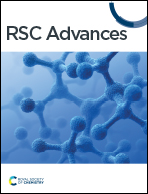Adsorption of Mn(ii) ions from wastewater using an AgNPs/GO/chitosan nanocomposite material†
Abstract
Water contaminated with heavy metal ions is extremely poisonous and threatens living organisms. Therefore, scientists place a premium on removing heavy metal ions from water that has already been contaminated. Removing metal ions from water typically involves the use of nanomaterials. Chitosan was made by extracting it from shrimp shells and combining it with a 3 : 1 ratio of synthetically produced AgNPs/GO. Fourier transform infrared spectroscopy (FTIR), scanning electron microscopy (SEM) with transmission electron microscopy (TEM), and X-ray diffraction were used to investigate an AgNPs/GO/chitosan nanocomposite (XRD). A number of studies must be run to determine the optimal pH, adsorbent quantity, retention period, stirring speed, temperature, and initial concentration. The studies were conducted in a variety of ways. The isotherms of Langmuir, Freundlich, and Dubinin–Radushkevich were utilized. The industrial wastewater was used in the column adsorption experiment, and the flow rates and column bed heights were varied. An optimum contact time, pH, and adsorbent dosage for Mn(II) were determined. At 30 minutes, pH 6, and 0.05 grams of Mn(II) adsorbent per 100 ml, with agitation at 250 rpm, room temperature of 30 °C, and an initial concentration of 40 ppm, the best conditions were discovered. A positive correlation coefficient finding (R2 = 0.925) indicates a good fit for Mn, according to equilibrium studies (II). The pseudo-second-order active model was connected to data that suited the pseudo-first and pseudo-second-order models. In the intra-particle diffusion model, the mechanism must proceed through four phases before equilibrium is reached. In an industrial adsorbent column, the adsorbent was put to the test. The periodicity test demonstrates that the nanocomposite's adsorption capability can be recovered by washing it with 0.1 M HCl. Mn(II) adsorbed on AgNPs/GO/Chitosan after four cycles was only 20%, insufficient for additional adsorption tests. The repeated cycles that led to the partial loss of the adsorbate may have reduced the adsorbent material's efficacy.



 Please wait while we load your content...
Please wait while we load your content...